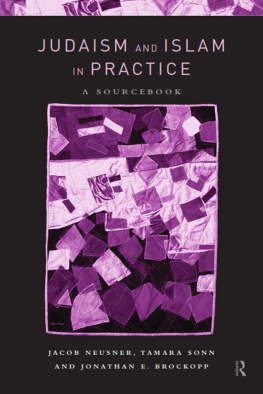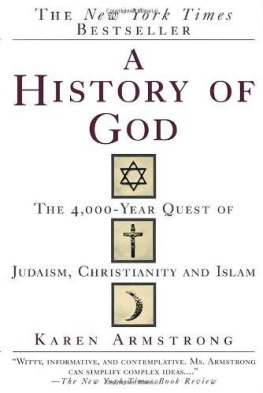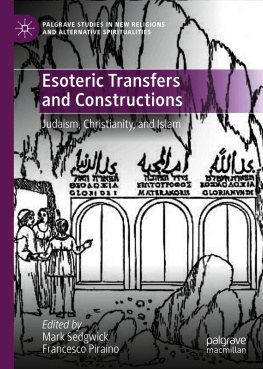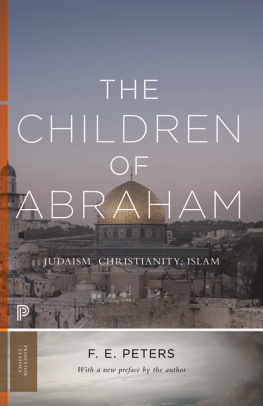Judaism and Islam compare because they concur that God cares deeply not only about attitudes but actions, not only about what one says to God but how one conducts affairs at home and in the village.
In this sourcebook, the authors have selected key passages from the laws of Judaism and Islam which allow a close examination of their mode of expression and medium of thought as well as the substance of the laws themselves. The selected passages concentrate on areas critical to the life of piety and faith as actually practised within the two faith-communities the relationship between the believer and God, between and among believers, at home in marriage, outside the home in the community and between the faithful and the infidels (for Islam) or idolaters (for Judaism).
JUDAISM AND ISLAM
IN PRACTICE
A Sourcebook
Jacob Neusner,
Tamara Sonn
and
Jonathan E. Brockopp

First published 2000
by Routledge
2 Park Square, Milton Park, Abingdon, Oxon 0X14 4RN
Simultaneously published in the USA and Canada
by Routledge
711 Third Avenue, New York, NY 10017
Routledge is an imprint of the Taylor & Francis Group
Transferred to Digital Printing 2005
2000 Jacob Neusner, Tamara Sonn and Jonathan E. Brockopp
The right of Jacob Neusner, Tamara Sonn and Jonathan E. Brockopp to be identified as the Author of this Work has been asserted by them in accordance with the Copyright, Designs and Patents Act 1988
Typeset in Adobe Garamond by Bookcraft Ltd, Stroud
All rights reserved. No part of this book may be reprinted or reproduced or utilised in any form or by any electronic, mechanical, or other means, now known or hereafter invented, including photocopying and recording, or in any information storage or retrieval system, without permission in writing from the publishers.
British Library Cataloguing in Publication Data
A catalogue record for this book is available from the British Library
Library of Congress Cataloging in Publication Data
Judaism and Islam in Practice : a sourcebook / [edited by]
Jacob Neusner, Tamara Sonn and Jonathan E. Brockopp.
252pp 23.4 x 15.6 cm.
Includes bibliographical references and index.
ISBN 0-415-21673-7 9 (he). ISBN 0-415-21674-5 (pbk)
1. JudaismRelationsIslamSources.
2. IslamRelationsJudaismSources.
3. Jewish lawSources. 4. Islamic lawSources.
5. Comparative lawSources.
I. Neusner, Jacob, 1932 II. Sonn, Tamara, 1949
III. Brockopp, Jonathan E., 1962
BP173J8J83 2000 99-34708
296.397dc21
ISBN 0-415-21673-7 (hbk)
ISBN 0-415-21674-5 (pbk)
CONTENTS
PREFACE
Judaism and Islam are comparable in that they concur that God cares deeply not only about attitudes but actions, not only about what one says to God but how one conducts affairs at home and in the village. God aims at sanctifying the social order, not only private life. Both religions agree that God aims at the reconstruction of society in accord with norms of holiness and that God has in so many words, through revealed writings to the prophets, specified precisely the character of those norms. So the two great traditions bear much in common. That fact permits comparison therefore also contrast. Why do so just now? Because this is an age in which, in the USA, Europe, and the Middle East, the monotheisms of law in the service of the All Merciful (as both call God) intersect once more, as they did a thousand years before. How the religions compare and contrast when, within the shared framework of convictions about the social, therefore legal, dimensions of theology, they speak in the same way about the same practical subjects defines the problem of this sourcebook.
Our goal is to provide readers with a direct encounter not only with the substance of the laws but also their language. That is why we set forth a sourcebook, in which lengthy abstracts allow close examination of Islamic and Judaic modes of expression and media of thought as much as the message of the religions concerning a subject they regard as critical to their respective accounts of the social order. We shall see that when we examine how Judaism and Islam portray the critical relationships that people maintain between themselves and God, among themselves in the community of the faithful, and between that community and the outsider we find a striking fact. It is that Judaism and Islam concur on a great many practical matters, using different language with the same result time and again. That does not mean the two are really saying the same thing and form a single religious tradition, divided in detail and perhaps in distinctive idiom that is far from the fact. It does mean that Judaism and Islam, by reason of their concentric character and their concurring judgments about what matters between God and humanity, may undertake a sustained dialogue on issues of common concern. Out of the classical sources of each, we mean to construct the wherewithal of one suchdialogue, the one concerning the practicalities of the religious life lived with God, conducted at home, and sustained in the face of difference beyond the circle of faith, home and family.
That aspiration to contribute to the common good explains the plan of the book. The three authors have chosen four areas, all of them critical to the life of piety and faith as actually practiced within the two faith-communities. They fall into three categories, defined by relationship, one covered by : between the believer and God, between and among believers, at home in marriage, outside the home in the community; and finally, between the faithful and the infidels (for Islam) or idolaters (for Judaism).
The first area of law addresses the life of the faithful with God and encompasses acts of piety in prayer, fasting, and ablutions. The second takes up the life of the faithful within their own community, both at home and in the fellowship of the faithful outside the walls of the household. The former involve relationships within the family betrothal, marriage, inheritance and divorce as these are topics deemed critical to the holy way of life under God's law by both Islam and Judaism in their classical, formative writings. The latter address the laws for the support of the poor, almsgiving and charity. The third category encompasses the laws regulating the relationship of the holy community to outsiders, in two aspects: first, defining who belongs to the community of the faithful; second, the matter of the Other in Judaism and Islam. In this way we offer an encompassing portrait of the practicalities of the two religions of law and show their numerous points of concurrence, also underscoring where and how they differ.
We deal only with the initial, and everywhere authoritative, statements of the two religions, their classical formulations. So we portray the religions within the ideal type set forth in their respective bodies of classical law, Scripture as set forth by the Mishnah and Talmud, c. 200-600 CE, for Judaism, and the Quran and Sunna of the Prophet as set forth by the classic handbooks of Islamic jurisprudence, c. 700-1000 CE for Islam. We propose to state matters in their initial, canonical presentations, with which all later authorities concur, and to which all subsequent theologians and lawyers turn for normative rules. Since we claim to state the generative norms of the two theological-legal traditions and compare and contrast them in their ideal formulation, we do not take up questions of variation over time or space and among diverse interpreters of the common tradition. What we compare are the formulations of Judaism and Islam by their classical authorities: God's revelation to Moses as portrayed in Scripture and recapitulated in Oral Tradition by the rabbis who produced the Mishnah and the Talmud, God's revelation to Muhammad as portrayed in the Qur'an and the practice of his Prophet, and explained by the legal scholars who produced the classic handbooks of Islamic law. We intend to provide a picture that all subsequent generations of Judaism andIslam to the present day will find accurate and familiar, even while taking account of later developments.









